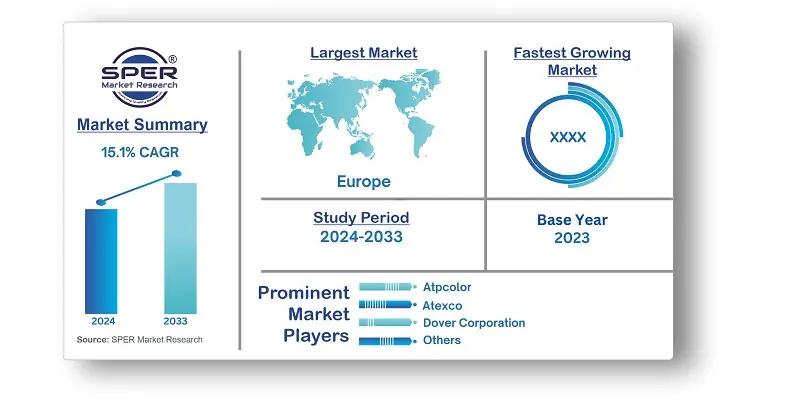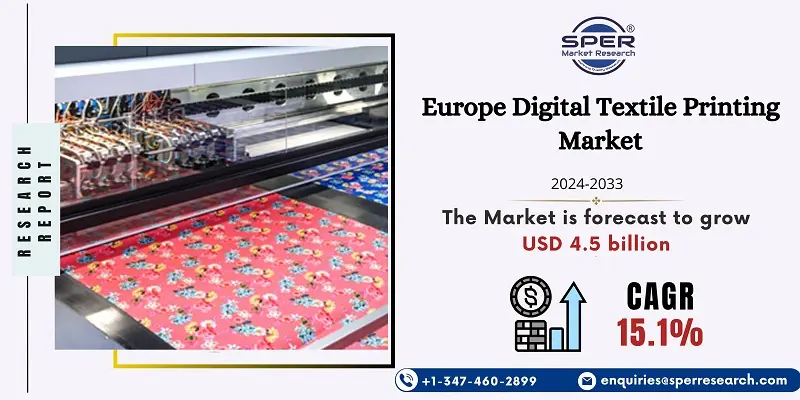
Europe Digital Textile Printing Market Growth, Size, Trends, Demand, Revenue and Future Outlook
Europe Digital Textile Printing Market Size- By Substrate Type, By Ink Type, By End User- Regional Outlook, Competitive Strategies and Segment Forecast to 2033
| Published: Mar-2024 | Report ID: CHEM2433 | Pages: 1 - 157 | Formats*: |
| Category : Chemical & Materials | |||


| Report Metric | Details |
| Market size available for years | 2020-2033 |
| Base year considered | 2023 |
| Forecast period | 2024-2033 |
| Segments covered | By Substrate Type, By Ink Type, By End Use |
| Regions covered | Germany, France, the UK, Spain, Italy, Turkey, Russia, Poland, Switzerland, Sweden, Norway, The Netherlands, Greece and Rest of Europe |
| Companies Covered | Atpcolor, Atexco, Dover Corporation, Epson, Efi Reggiani, Hollanders Printing Systems B.V., Konika Minolta, Kornit Digital, Mehler Texnologies Gmbh, Texintel, Others |
- Textile Manufacturers
- Fashion Designers
- Advertising and Marketing Agencies
- Retailers and Brands
- Interior Designers
- Printing Service Providers
- Educational Institutions
- Others
| By Substrate Type: |
|
| By Ink Type: |
|
| By End Use: |
|
- Europe Digital Textile Printing Market Size (FY’2024-FY’2033)
- Overview of Europe Digital Textile Printing Market
- Segmentation of Europe Digital Textile Printing Market By Substrate Type (Cotton, Polyester, Silk, Others)
- Segmentation of Europe Digital Textile Printing Market By Ink Type (Acid, Direct Dispense, Pigments, Reactive, Sublimation, Others)
- Segmentation of Europe Digital Textile Printing Market By End Use (Clothing, Display, Household, Technical Textiles, Others)
- Statistical Snap of Europe Digital Textile Printing Market
- Expansion Analysis of Europe Digital Textile Printing Market
- Problems and Obstacles in Europe Digital Textile Printing Market
- Competitive Landscape in the Europe Digital Textile Printing Market
- Impact of COVID-19 and Demonetization on Europe Digital Textile Printing Market
- Details on Current Investment in Europe Digital Textile Printing Market
- Competitive Analysis of Europe Digital Textile Printing Market
- Prominent Players in the Europe Digital Textile Printing Market
- SWOT Analysis of Europe Digital Textile Printing Market
- Europe Digital Textile Printing Market Future Outlook and Projections (FY’2024-FY’2033)
- Recommendations from Analyst
1.1. Scope of the report1.2. Market segment analysis
2.1. Research data source2.1.1. Secondary Data2.1.2. Primary Data2.1.3. SPER’s internal database2.1.4. Premium insight from KOL’s2.2. Market size estimation2.2.1. Top-down and Bottom-up approach2.3. Data triangulation
4.1. Driver, Restraint, Opportunity and Challenges analysis4.1.1. Drivers4.1.2. Restraints4.1.3. Opportunities4.1.4. Challenges4.2. COVID-19 Impacts of the Europe Digital Textile Printing Market
5.1. SWOT Analysis5.1.1. Strengths5.1.2. Weaknesses5.1.3. Opportunities5.1.4. Threats5.2. PESTEL Analysis5.2.1. Political Landscape5.2.2. Economic Landscape5.2.3. Social Landscape5.2.4. Technological Landscape5.2.5. Environmental Landscape5.2.6. Legal Landscape5.3. PORTER’s Five Forces5.3.1. Bargaining power of suppliers5.3.2. Bargaining power of buyers5.3.3. Threat of Substitute5.3.4. Threat of new entrant5.3.5. Competitive rivalry5.4. Heat Map Analysis
6.1. Europe Digital Textile Printing Market Manufacturing Base Distribution, Sales Area, Product Type6.2. Mergers & Acquisitions, Partnerships, Product Launch, and Collaboration in Europe Digital Textile Printing Market
7.1. Europe Digital Textile Printing Market Value Share and Forecast, By Substrate Type, 2024-20337.2. Cotton7.3. Polyester7.4. Silk7.5. Others
8.1. Europe Digital Textile Printing Market Value Share and Forecast, By Ink Type, 2024-20338.2. Acid8.3. Direct Dispense8.4. Pigments8.5. Reactive8.6. Sublimation8.7. Others
9.1. Europe Digital Textile Printing Market Value Share and Forecast, By End Use, 2024-20339.2. Clothing9.3. Display9.4. Household9.5. Technical Textiles9.6. Others
10.1. Europe Digital Textile Printing Market Size and Market Share
11.1. Europe Digital Textile Printing Market Size and Market Share By Substrate Type (2020-2026)11.2. Europe Digital Textile Printing Market Size and Market Share By Substrate Type (2027-2033)
12.1. Europe Digital Textile Printing Market Size and Market Share By Ink Type (2020-2026)12.2. Europe Digital Textile Printing Market Size and Market Share By Ink Type (2027-2033)
13.1. Europe Digital Textile Printing Market Size and Market Share By End Use (2020-2026)13.2. Europe Digital Textile Printing Market Size and Market Share By End Use (2027-2033)
14.1. Europe Digital Textile Printing Market Size and Market Share By Region (2020-2026)14.2. Europe Digital Textile Printing Market Size and Market Share By Region (2027-2033)14.3. France14.4. Germany14.5. Greece14.6. Italy14.7. Norway14.8. Poland14.9. Russia14.10. Spain14.11. Sweden14.12. Switzerland14.13. The Netherlands14.14. Turkey14.15. UK14.16. Rest of Europe
15.1. Atpcolor15.1.1. Company details15.1.2. Financial outlook15.1.3. Product summary15.1.4. Recent developments15.2. Atexco15.2.1. Company details15.2.2. Financial outlook15.2.3. Product summary15.2.4. Recent developments15.3. Dover Corporation15.3.1. Company details15.3.2. Financial outlook15.3.3. Product summary15.3.4. Recent developments15.4. Epson15.4.1. Company details15.4.2. Financial outlook15.4.3. Product summary15.4.4. Recent developments15.5. Efi Reggiani15.5.1. Company details15.5.2. Financial outlook15.5.3. Product summary15.5.4. Recent developments15.6. Hollanders Printing Systems B.V.15.6.1. Company details15.6.2. Financial outlook15.6.3. Product summary15.6.4. Recent developments15.7. Konika Minolta15.7.1. Company details15.7.2. Financial outlook15.7.3. Product summary15.7.4. Recent developments15.8. Kornit Digital15.8.1. Company details15.8.2. Financial outlook15.8.3. Product summary15.8.4. Recent developments15.9. Mehler Texnologies Gmbh15.9.1. Company details15.9.2. Financial outlook15.9.3. Product summary15.9.4. Recent developments15.10. Texintel15.10.1. Company details15.10.2. Financial outlook15.10.3. Product summary15.10.4. Recent developments15.11. Others
SPER Market Research’s methodology uses great emphasis on primary research to ensure that the market intelligence insights are up to date, reliable and accurate. Primary interviews are done with players involved in each phase of a supply chain to analyze the market forecasting. The secondary research method is used to help you fully understand how the future markets and the spending patterns look likes.
The report is based on in-depth qualitative and quantitative analysis of the Product Market. The quantitative analysis involves the application of various projection and sampling techniques. The qualitative analysis involves primary interviews, surveys, and vendor briefings. The data gathered as a result of these processes are validated through experts opinion. Our research methodology entails an ideal mixture of primary and secondary initiatives.



Frequently Asked Questions About This Report
PLACE AN ORDER
Year End Discount
Sample Report
Pre-Purchase Inquiry
NEED CUSTOMIZATION?
Request CustomizationCALL OR EMAIL US
100% Secure Payment






Related Reports
Our Global Clients
Our data-driven insights have influenced the strategy of 200+ reputed companies across the globe.




















